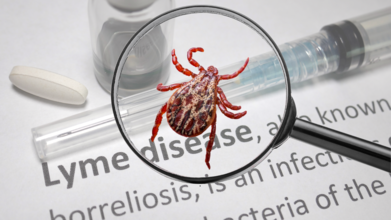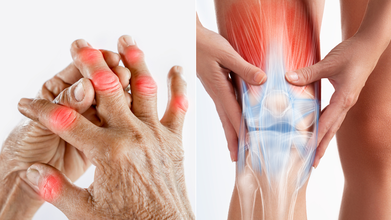- Health Conditions A-Z
- Health & Wellness
- Nutrition
- Fitness
- Health News
- Ayurveda
- Videos
- Medicine A-Z
- Parenting
- Web Stories
Lyme Disease In US: How Worried Should You Be Of Ticks?

Credits: Canva
The United States have been long suffering from various disease, and now is the season of ticks. On the rise is Lyme disease, and tick bites have recorded the a 5-year high ER visits in Northeast, reports 12 News. The Health and Me had previously reported on the surge that ERs across the US is experiencing, wit the highest in July, since 2017. he Centers for Disease Control and Prevention (CDC) reports that close to 31 million Americans suffer from tick bites every year, and this summer saw a sharp increase, particularly in the Northeast.
The CDC says that the Fordham Tick Index, which monitors tick activity in southern New York, Connecticut, and northern New Jersey, is now at a "very high" risk level, 9 out of 10.
What Could Be The Reason For This High?
Experts are attributing this surge to environmental shifts, growing deer numbers, and more human presence within woodlands.
Not Just The US, But UK Too Issues A Public Health Warning
Previously Health and Me also reported that with the unexpected wave of heat in the UK, the UK Health Security Agency (UKHSA) has issued a public warning against a small, almost invisible threat that could send you to the hospital.
Taking simple steps can help you avoid these bugs that could leave you with flu-like symptoms lasting for weeks.
Case Study
Amid the tick season, Health and Me reported on a case of an 8-year-old boy who has Lyme disease. The case points out on the cases of how, when symptoms ignored, or with lack of caution and awareness can ticks become a real threat.
Lyme Disease: How Worried Should One Be Of Ticks?
Most tick-borne diseases in the United States are rare, with one big exception, reports the New York Times (NYT). Lyme disease is far more common than any other tick-related illness.
In fact, it's 12 times more prevalent than the next most common disease, anaplasmosis. In some regions, up to 50% of adult ticks carry the bacteria that cause Lyme, making it the leading tick-borne illness in the country.
“That’s our biggest concern,” said Erika Machtinger, an entomologist and head of the vector-borne disease team at Pennsylvania State University Extension, as noted by the NYT. “There aren’t vaccines in development for anything else; there is for Lyme disease.”
While Lyme disease is typically treatable, especially if antibiotics are taken within 72 hours of a bite, it can be tricky to diagnose. When missed, it may lead to lingering symptoms that persist for years after treatment.
Location Matters Most
Ticks exist throughout most of the continental U.S., but risk levels vary greatly by location. Some places have ticks that barely transmit disease, while others see thousands of Lyme cases each year.
“Where you live matters more than anything,” explained Jean Tsao, an ecologist and Lyme expert at Michigan State University, reports NYT.
That can influence everything — from what one wears on a hike to how they move through outdoor spaces.
For instance, in Arizona, where tick-related illnesses are rare, residents might wear shorts and sandals without much concern.
But in Michigan, where Lyme disease is on the rise, Tsao recommends wearing long pants, socks with shoes, and clothing treated with Permethrin, a fabric-safe repellent.
“I never walk into the woods with Tevas or Chacos anymore,” she said. “And I wouldn’t say I’m paranoid.”
How Common Is Lyme Disease?
Lyme disease is most common in the Northeast and Upper Midwest, where tick populations have been established for decades. In 2023, Rhode Island reported over 2,800 cases, while Texas had only 27. Areas newly seeing Lyme-carrying ticks, like parts of Michigan, may still have fewer cases, but the numbers are rising.
Even urban parks can pose a risk, as ticks only need a few host animals like birds, rodents, or raccoons to survive.
Tick Type Makes a Difference
Not all ticks are equally dangerous. The blacklegged tick, also known as the deer tick, is the primary carrier of Lyme bacteria.
Other types, like the lone star tick or dog tick, can transmit disease but pose less of a threat.
Blacklegged ticks go through three life stages, and take a blood meal at each. Adults are most likely to carry Lyme, while larvae rarely do. Surprisingly, most Lyme infections happen during the nymph stage, when ticks are smaller and harder to see.
These tiny nymphs often attach in areas that are hard to inspect. “The toilet is a great place to check for ticks,” said Machtinger. “You can reach all your crevices. I know it sounds weird, but it’s true.”
If someone finds a tick, the first step is to identify the species. This can be done via a healthcare provider, a tick ID website, or local university extension services. Ticks can be stored in a Ziploc bag or between strips of Scotch tape for identification. If the tick is a deer tick and the bite occurred within 72 hours, a single dose of antibiotics can reduce the risk of illness. Otherwise, one should monitor for rashes and flu-like symptoms.
Tick Behavior Basics
Ticks can bite anywhere on the body, but they tend to favor warm, hidden areas like the groin, armpits, and behind the ears. Where the tick attaches can also depend on activity. For example, a tick found while hiking is likely to be on the lower body, while one from gardening might show up on an arm.
Those with darker skin tones may find ticks harder to detect. “You have to get to know your freckles really, really well,” said Machtinger.
The good news? Ticks don’t bite immediately, and they typically need 24 hours to transmit Lyme after attaching. That means regular tick checks, especially after spending time outdoors, are highly effective. Showering soon after outdoor activity can also help wash off ticks before they embed.
Additionally, ticks die quickly in a clothes dryer, making it a good idea to tumble dry outdoor clothes on high heat after an outing.
Despite their reputation, ticks are delicate creatures that can be hard to study in labs. Over time, scientists who work with them may even find them "almost cute," Machtinger added. While most people may never go that far, understanding the real risks they pose, and how to prevent them, can take some of the fear out of tick season.
New Developments Like Lower Doses of Radiation And Drug-filled Cartilage Could Help In Arthritis Treatment

Credits: Canva
Each year on October 12 the world observes Arthritis Day to bring attention to the medication condition and ways to find out to prevent and to treat it as there is no cure. However, apart from the traditional treatments like medication, physical therapy, lifestyle changes, and surgery to manage symptoms, there have ben new treatments in the recent times too. Before jumping into what those treatments are, let us first understand what is arthritis?
It is a medical term for joint pain, inflammation, and stiffness, with over 100 different types. It also includes osteoarthritis and rheumatoid arthritis.
Osteoarthritis: It is a progressive, degenerative joint disease where the protective cartilage cushioning the ends of the bones breaks down. It then causes pain, stiffness, swelling and reduced mobility and affects the hands, knees, hips and spine.
Rheumatoid Arthritis: It is a chronic autoimmune disease that causes pain, swelling, stiffness, and warmth in the joints and affects mostly small joints of hands and feet in a symmetrical pattern. It occurs when the immune system attacks the body's own tissue, particularly the lining of the joints and leads to inflammation or even damage to cartilage and bones.
What Are The New Treatment On Arthritis?
As per the multiple new studies present at the American Society of Radiation Oncology (ASTRO), 2025, researchers from Korea, the US, and Germany reported that mild doses of radiation can significantly reduce pain and also improve mobility in patients with osteoarthritis.
Radiation Therapy For Arthritis
In South Korea, a randomized clinical trial was conducted with 114 volunteers, who had knee arthritis, and were treated with 3 Gy of radiation, which had spread over six sessions. Researchers also noticed that 70% of participants experienced meaningful improvement in pain, function and overall functioning. This was way higher than the 42% improvement seen in the placebo group.
Low-dose radiation is already common in the Europe. However, strong randomized data was limited till now. Dr Byong Hyuck Kim of the Seoul National University, who led the study also emphasized that here, the radiation doses are 10 to 20 times lower than cancer therapy levels and targets only the joints far from the vital organs.
Artificial Cartilage Helps Arthritis
Researchers from the University of Cambridge designed an artificial cartilage that could help with arthritis treatment. This 'cartilage' can sense tiny changes in the body, including arthritis flare-up and release drugs exactly when and where they are needed.
The 'cartilage' is squishy in nature and can be loaded with anti-inflammatory drugs that are released in response to small changes in pH in the body. During arthritis flare-up, joint becomes inflamed and more acidic. The 'cartilage' becomes softer as the change in pH is noticed, especially when the acidity increases and it triggers the release of drug molecules that can be encapsulated within its structure.
The entire study is published in the Journal of American Chemical Society.
World Arthritis Day 2025: Date, Theme, Significance And History Explained

Credits: Canva
Every year, people across the world unite on World Arthritis Day to spread awareness about arthritis and related disorders. Observed annually on October 12, the day aims to draw attention to the everyday challenges faced by those living with arthritis, encourage early diagnosis, and promote better medical care and support systems.
As World Arthritis Day 2025 approaches, it’s a timely reminder to learn about its theme, importance, and the role each of us can play in improving the lives of those affected.
Why World Arthritis Day Matters
Arthritis is often mistaken for a simple case of joint pain, but it is far more complex. It includes a wide range of conditions that can impact a person’s mobility, independence, and overall well-being. One of the main goals of World Arthritis Day is to break these misconceptions, spread accurate information, and raise awareness that arthritis can affect anyone, regardless of age.
Raising awareness also encourages timely medical consultation, physiotherapy, and healthier lifestyle choices that can help manage symptoms and prevent complications.
World Arthritis Day 2025 Theme
The theme for World Arthritis Day 2025 is “Realizing Your Dreams” or “The Courage to Dream.” This year’s message highlights the importance of personal aspirations and resilience among people living with rheumatic and musculoskeletal diseases (RMDs). It inspires individuals to pursue their dreams while encouraging collaboration between patients, doctors, and advocates to turn those dreams into reality.
The theme serves as a reminder that arthritis is not just a physical condition, it is about preserving one’s independence, dignity, and quality of life.
When Is World Arthritis Day Celebrated?
World Arthritis Day is marked every year on October 12 around the globe. In India too, this day is recognised and observed to underline the importance of awareness and education about arthritis. With lifestyle changes and rising stress levels, arthritis is now being diagnosed in younger people as well, making awareness even more vital.
Ways to Raise Awareness on World Arthritis Day 2025
Spreading awareness is not limited to medical professionals or organizations. Every individual can help in small but meaningful ways. Some simple ideas include:
- Educational Programs: Schools, offices, and community groups can organize sessions to teach people about arthritis symptoms and preventive care.
- Social Media Campaigns: Sharing real-life stories, verified facts, and official theme posters can reach thousands online.
- Community Events: Walkathons or charity runs can raise both funds and awareness.
- Free Health Camps: Clinics and hospitals can offer free joint check-ups to encourage early diagnosis.
These collective efforts ensure that arthritis is not ignored or misunderstood, but openly discussed and addressed.
Tips for Living with Arthritis
Awareness is the first step, but supporting those who live with arthritis every day is just as important. Here are some ways to help manage the condition and maintain a good quality of life:
Stay Active, but with Care
Choose gentle exercises such as walking, yoga, or swimming to keep joints flexible and reduce stiffness without straining them.
Eat a Balanced Diet
Include anti-inflammatory foods such as leafy greens, fatty fish rich in omega-3, nuts, and olive oil to help ease inflammation.
Get Enough Rest
Quality sleep helps the body recover. Avoid overexertion but stay active enough to prevent stiffness.
Use Supportive Tools if Needed
Walking sticks, braces, or other assistive devices can reduce stress on joints and make movement easier.
Maintain a Positive Outlook
Joining arthritis support groups or connecting with others who share similar experiences can provide motivation and emotional support.
For those seeking specialized treatment, visiting a reputed multispeciality hospital in Coimbatore can help patients receive comprehensive arthritis care, from diagnosis to therapy and rehabilitation, under one roof.
Is Donald Trump Showing Early Phonemic Paraphasia? Here’s Why Health Experts Think So

As Donald Trump recently went for his second health checkup, the visit, announced earlier this week by the White House comes as he prepares to travel to the Middle East following a ceasefire deal in the Israel-Hamas war. White House press secretary Karoline Leavitt called it a “routine yearly checkup,” even though the president had already undergone his annual physical in April. According to a memo obtained by CBS News on Friday evening, written by Trump’s physician, Capt. Sean Barbabella, the president “successfully completed a scheduled follow-up evaluation.”
The president also received his annual flu vaccination and an updated COVID-19 booster. Interestingly, his cardiac age, a validated measure of cardiovascular health via ECG was found to be roughly 14 years younger than his chronological age. However, health experts remain concerned, with many noting potential signs of dementia. Now, some specialists are also pointing to early indicators of phonemic paraphasia in his speech.
What Is Phonemic Paraphasia That Health Experts Believe Donald Trump Has Signs Of?
Phonemic paraphasia is a type of speech error where sounds within a word are substituted, added, or rearranged, creating a nonword that still sounds similar to the intended word (for example, “tephelone” instead of “telephone”). It is commonly seen in language disorders such as Wernicke’s aphasia and conduction aphasia, caused by difficulty selecting the correct phonemic segments. People with this condition usually understand what they want to say but struggle with producing the correct sounds.
What Are Psychologists Saying About Donald Trump’s Health?
Even during Trump’s first term, his cognitive and psychological traits attracted attention. Observers noted he struggled to focus on a single topic, and his public remarks raised concern among psychiatrists. In 2017, 27 mental health professionals collectively published The Dangerous Case of Donald Trump, warning that his mental state, combined with presidential powers, could pose risks to global security.
Dr. Bandy Lee, who taught for 17 years at Yale School of Medicine, first noticed potential neurocognitive issues in Trump in 2017 and says his condition has steadily declined since then. The manifesto, published on Nov. 3, 2024, titled Statement on Cognitive Decline in the Presidential Election, lists symptoms including simpler vocabulary, incomplete sentences, grammatical mistakes, paraphasias, vague or inappropriate statements, compulsive repetition of thoughts (“perseveration”), increased use of profanity, and pronounced narcissistic traits.
Some of Trump’s invented words even went viral during his first term. The infamous “covfefe” tweet is one example, where he likely meant “coverage” but created a nonsensical word that became a meme and appeared on protest signs and in advertisements.
Health Experts Believe Donald Trump Also Has Dementia
Harry Segal, a senior psychology lecturer at Cornell University, has observed early signs of dementia in Trump. “What’s alarming is how the rate of Trump’s unusual speech and political decisions has been increasing. He once gave an incoherent answer about childcare to the Economic Club of New York… Trump has shown evidence of dementia over the past year, indicated by his strange gait, phonemic paraphasia, and a decline in word complexity,” Segal said. He believes these factors explain Trump’s refusal to debate Kamala Harris a second time and his increasingly impulsive speeches.
What Are the Symptoms of Phonemic Paraphasia?
The main symptom is substituting a word with a nonword that sounds similar, such as saying “wishdasher” instead of “dishwasher.” Other signs include:
- Errors where sounds in a word are replaced with different sounds
- Producing non-real words that resemble the intended word
- Difficulty finding words and substituting unrelated terms (semantic paraphasia)
- Repeated attempts to correct themselves, sometimes abandoning the word entirely
- Lack of awareness of these mistakes
Who Is Affected by Phonemic Paraphasia?
- Individuals with aphasia: Particularly Wernicke’s and conduction aphasia
- People with brain lesions: Often in the posterior temporal lobe or internal/external capsules, areas involved in language
- Individuals with other neurological conditions: Early dementia is frequently associated with phonemic paraphasia
© 2024 Bennett, Coleman & Company Limited

